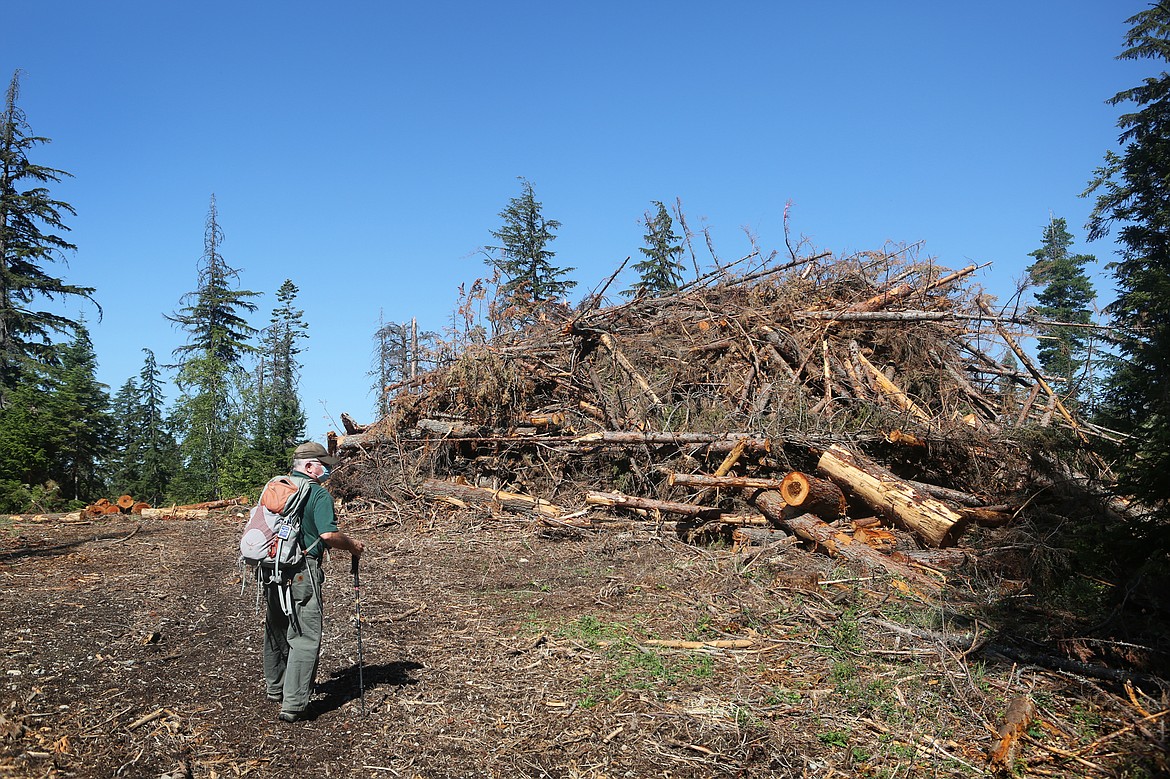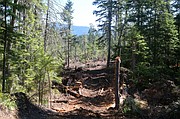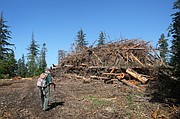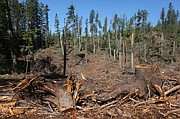Logging planned near Broken Leg, Crater Notch trails
Page header: Outdoors
Header: Jewel Basin
Headline: Logging planned near Broken Leg, Crater Notch trails
SUbhead: Conservation group concerned with logging practices, tree removal near trails
The Kalispell unit of the Department of Natural Resources and Conservation is planning a timber sale on 350 acres in the Jewel Basin area to remove blown down and wind damaged timber, beginning as early as October. According to the Aug. 7 scoping notice, the aim of the project is to reduce fire fuels near property boundaries and generate trust revenues for Montana State University and the School for the Deaf and Blind.
Trust lands in Montana are managed with the objective of generating revenue for the trust beneficiaries, which include K-12 public schools and the Montana University System, among others. Funds are generated through various methods including timber sales -- where logging companies purchase the rights to harvest timber from a given area -- along with land leases and the sale of mineral royalties. In 2019, these trust lands provided $45.9 million for schools statewide.
“We don’t really have that choice to leave it on school trust lands,” said Dave Poukish, the Kalispell Unit Manager for DNRC. “These are not public lands; these are trust lands. We answer to the beneficiaries. There’s a lot of rules and laws we have to follow. If there's blowdown we have to pick it up because there’s economic value.”
However, the project area also encompasses sections of two public trails -- the Echo Broken Leg Trail and Crater Notch Trail, drawing concern from local conservationist group, Swan View Coalition. According to a project map provided by DNRC, Echo Broken Leg Trail runs through the middle of the project, while Crater Notch breaks off Echo Broken Leg toward the east side of the project area.
Poukish said that both trails will likely be impacted by salvage logging activities, but noted that any blowdown across the trails will also be retrieved.
“We would ensure that the integrity of the trail is still passable,” he said, although the DNRC would not perform any maintenance beyond that.
Swan View Coalition expressed worries that the logging would result in damage to these routes and noted that in previous years, the DNRC agreed to keep logging away from these same areas.
In an Aug. 10 letter to DNRC and the Swan Lake Ranger District, coalition president Keith Hammer explained that in 2006 the DNRC had also planned a timber salvage project within the vicinity of Echo Broken Leg Trail. In the case of that project, called the Foothills Timber Sale, Hammer said DNRC agreed to adjust the logging boundary to be out of sight of the trail and hoped the same could be achieved in the case of the Jewel Basin Blowdown Salvage project.
“In terms of priority, we recognize that these agencies are going to do some logging somewhere but why can't they stay away from high-use public trails and leave those areas be?” Hammer told the Eagle. “It’s not like the public in these cases are asking them to stay out of an entire mountain range. One person makes a promise and that doesn't carry to the next person in that bureaucracy.”
Poukish said that while trust lands offer opportunities for public recreation, the DNRC manages the land in the best interest of the trust beneficiaries and is required by law to salvage timber before it loses economic value, according to Montana Code Annotated 77-5-207.
He further explained that logging would likely occur in the winter months to help minimize damage to the soil but that trail closures may be required depending on “operational timing and exposure to the public.”
“If so, they would be short in duration,” he added.
Poukish also noted that removing blowdown would reduce the risk for forest fires, which was important, especially given that the project area is near residential neighborhoods.
“Blown down timber adds ladder or ground fuels to an area that could increase the risk of crown fires, which are much more difficult to contain and suppress,” wrote Poukish.
“By leaving material on the ground you get larger fires, higher intensity fires, and there's a lot of people that are concerned about that in this valley,” he said in a followup interview.
Salvage logging is the practice of removing logs in the aftermath of a natural disturbance such as wildlife, insect infestation, or in the case of the Jewel Basin Blowdown Salvage, wind storms. The practice is intended to get the damaged trees out of the area while they still have monetary value. Poukish said DNRC is still in the process of completing an environmental assessment so no contract has been awarded for the Jewel Basin Salvage, however recent projects in the area have fetched prices of $40 per ton or $1,200 per truckload of timber. The Forest Service is also in the process of conducting a salvage project in scattered areas along the east shore of the Flathead Lake and southeast of Swan Lake, known as the March Madness Blowdown Salvage. As with the Jewel Basin Salvage project, the March Madness project aims to reduce fire fuels by removing blown down timber.
But this type of logging is not without controversy. Salvage logging has become a common practice by forest managers, and proponents tout its economic benefits and potential for reducing fire hazards or insect infestations. Opponents argue that the forest should be left as is, that trees should decompose naturally, depositing nutrients back into the soil or providing homes for certain species.
Salvage logging isn't new to the Bigfork area -- in 2014, F.H. Stoltze logged DNRC lands around the Crater Notch Trail as part of the Birch Creek Salvage and more recently, salvage logging occurred in the Krause Basin region, also managed by DNRC.
According to the Montana DNRC State Forest Land Management Plan, there is a reason to revisit previously logged areas.
“We identify areas where harvests have occurred in the past and use existing trails for new harvests to limit the area of disturbance.” the plan states.
But Hammer said the 2014 Birch Creek Salvage project resulted in damage to the Crater Notch Trail and was worried the Jewel Basin project would come with similar consequences.
“One tree, if it’s a big tree, can make a heck of a gauge in the ground when you’re dragging it with the limbs on. Some of the limbs break … and it’s like running a great big harrow through the ground. Mainly, it tears out the trail tread and that needs to be redug,” he said. “They didn't just go in and cut up the trees that were blown over … It's like whatever they want to take, they've got an excuse.”
Poukish pointed out that while the Jewel Basin Salvage project was similar to Krause Basin, logging would “follow best management practices” and the state’s forest management plan.
“By promoting biodiversity we will protect the future income generating capacity of the land by maintaining or restoring healthy and productive ecosystems,” the plan states.
But in Hammer’s eyes, that’s not what’s happening on the ground. Hammer expressed concerns that the salvage logging wasn’t limited to damaged trees -- and smaller trees that were more likely to present a fire hazard were left behind.
“The logging we’ve seen is heavy-handed, careless and cannot with a straight face be called ‘fuels reduction,’ as the big logs that don’t generally burn in a wildfire are being removed while the more flammable small trees and slash are being left behind,” Hammer wrote in an email that also contained photographs of the area post-logging.
He further alleged that in the Krause Basin, trees that were moved weren’t limited to blowdown.
“They took some and a lot of them were really healthy. We saw them days after they were cut,” Hammer said.
When asked to address these claims, Poukish said the trees that had been removed were also affected by the wind events.
“Many of the trees were blown down,” Poukish said, “but there were also trees with excessive lean, broken tops, and pulled roots due to the wind event.”
Logging remains a contentious issue throughout the state — and the same is true right here in Bigfork. So what’s next for the project? Before salvage logging can begin, the DNRC must complete an environmental assessment and find a buyer for the timber contract. Public comment concluded after a two-week period ending Aug. 21, but interested parties can learn more by contacting the DNRC directly. Email Pete Seigmund at pseigmund@mt.gov or review the project scoping notice at http://dnrc.mt.gov/public-interest/public-notices.




